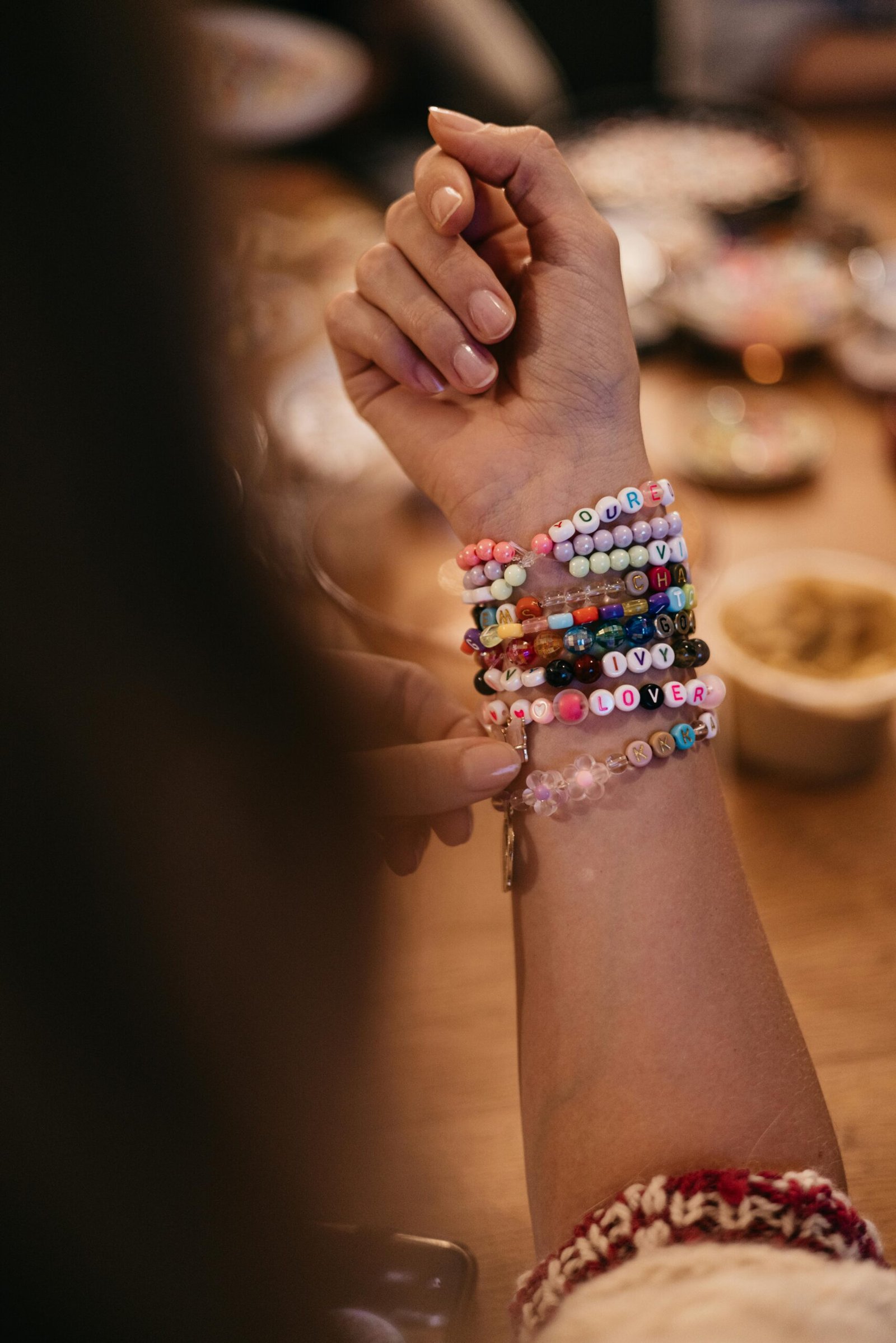String bracelets are a popular accessory that can add a touch of style and charm to any outfit. However, anyone who has ever worn a string bracelet knows that they are prone to wear and tear, which can lead to them unraveling or breaking completely. But fret not, because we have some effective tips that will help you prevent the wear and tear of your beloved string bracelets. By following these simple tricks, you can ensure that your bracelets stay in pristine condition for a longer period of time, allowing you to continue rocking them with confidence. So, keep reading to discover these valuable tips and say goodbye to the hassle of constantly repairing or replacing your favorite string bracelets.

This image is property of images.pexels.com.
Choose High-Quality Materials
When it comes to string bracelets, choosing high-quality materials is essential to ensure their durability and longevity. One of the first things to consider is the string material itself. Opt for durable and strong materials that can withstand regular wear and tear. Some popular options include nylon, cotton, or polyester strings, as they are known for their strength and resilience.
Aside from the string, it is equally important to select high-quality beads and charms. Look for materials that are known for their durability, such as sterling silver, stainless steel, or gemstone beads. Cheap or low-quality beads and charms are more prone to chipping, discoloration, or breakage, which can impact the overall appearance and functionality of the bracelet.
Another factor to consider when choosing materials is their tendency to fray or break easily. Avoid materials that are known to be fragile or prone to damage, such as silk or thin threads. These materials may not withstand everyday use and may require frequent repairs or replacements. Opting for sturdier materials will ensure that your string bracelet can withstand daily wear without losing its charm.
Proper Bracelet Sizing
Proper sizing is key to ensuring that your string bracelet fits comfortably and securely on your wrist. Before making a purchase, be sure to measure your wrist accurately to determine the right size. This can be done using a flexible measuring tape or a piece of string that can be measured against a ruler. By knowing your wrist size, you can choose a bracelet that is not too tight or too loose.
Bracelets that are too tight can cause discomfort and restrict blood circulation, while those that are too loose may slide off easily or get caught on objects, increasing the risk of damage or loss. It’s important to find the perfect balance between a snug fit and freedom of movement.
Consider adjustable bracelets for added flexibility. These bracelets typically have a sliding mechanism or adjustable knots that allow you to customize the size according to your preference. This can be particularly beneficial if you have trouble finding the exact size that fits your wrist comfortably. Adjustable bracelets offer versatility and can easily be shared or worn on different wrists.

This image is property of images.pexels.com.
Avoid Excessive Stretching
While string bracelets are generally designed to have some stretch to them, it is important to avoid excessive stretching that can impact their lifespan. Be mindful and try to avoid pulling or tugging on the bracelet excessively. Exerting too much force on the bracelet can weaken the strings, leading to potential breakage or stretching.
It is advisable to take off the bracelet when engaging in activities that may stretch it, such as weightlifting or participating in contact sports. The excessive force and movement involved in these activities can put a significant strain on the bracelet, increasing the risk of damage. By removing the bracelet beforehand, you can ensure its protection and prevent unnecessary wear and tear.
When it comes to putting on or taking off the bracelet, take care to do so gently to minimize stretching. Pulling or yanking the bracelet forcefully can lead to its stretching out of shape or causing damage to the delicate components like beads or charms. Be mindful of your movements and treat the bracelet with care to maintain its integrity over time.
Keep Bracelet Dry
Moisture can be detrimental to the lifespan of string bracelets, so it’s important to keep them dry as much as possible. Avoid wearing the bracelet in water or exposing it to excessive moisture. Water can weaken the strings and cause them to lose their integrity, leading to fraying or breakage.
It is essential to remove the bracelet before showering, swimming, or doing the dishes. The prolonged exposure to water, soap, and other chemicals can have a negative impact on the bracelet’s materials, causing them to deteriorate or lose their original appearance. Protect your bracelet by taking it off before immersing yourself in water-related activities.
If your bracelet does get wet, make sure to dry it thoroughly. Wet strings can harbor moisture, creating a breeding ground for mold or mildew, which can be damaging to the bracelet and potentially affect your skin as well. Use a clean, dry cloth to gently pat the bracelet dry, ensuring that there is no residual moisture left behind.

This image is property of images.pexels.com.
Store Bracelet Properly
Proper storage is crucial in maintaining the quality and appearance of your string bracelet. When not in use, store your bracelet in a cool, dry place away from direct sunlight or extreme temperatures. Exposure to heat and sunlight can cause the colors of the beads or charms to fade and the string to weaken or become brittle.
Consider using a jewelry box or pouch to protect the bracelet from dust, moisture, and potential damage. This can help prevent scratches, tangling, or the bracelet getting snagged on other objects. In addition, storing your bracelet separately from other jewelry items can minimize the risk of them rubbing against each other and causing unnecessary wear or damage.
Avoid Chemicals and Harsh Substances
String bracelets are sensitive to chemicals and harsh substances, so it’s important to avoid contact with them. Perfumes, lotions, and other skincare or beauty products can contain chemicals that can tarnish or corrode the beads, discolor the string, or cause other unwanted reactions. To protect your bracelet, take it off before applying such products to your skin.
Cleaning agents and harsh substances used for household chores can also be detrimental to your bracelet’s longevity. These substances can degrade the materials, weaken the strings, or strip the luster and shine off the beads or charms. It is advisable to remove the bracelet or wear protective gloves while cleaning to avoid any accidental contact.
Regular Cleaning
Just like any other piece of jewelry, string bracelets require regular cleaning to keep them looking their best. Gently clean the bracelet using mild soap and water. Fill a small container with lukewarm water and add a few drops of mild soap or detergent. Swish the bracelet in the soapy water for a few seconds, being careful not to agitate it too much.
Use a soft brush or cloth to remove any dirt or residue that may be stuck on the beads or string. Gently scrub the surface while ensuring not to put excessive pressure, as this can cause the string to stretch or the beads to chip. Rinse the bracelet thoroughly with clean water to remove any soap residue, and carefully pat it dry with a clean towel.
Avoid using harsh chemicals or abrasive materials for cleaning as they can damage the delicate components. Harsh chemicals can tarnish the beads or cause them to lose their shine, while abrasive materials can scratch or chip the beads and weaken the string. Stick to mild cleaning solutions and gentle methods to maintain the bracelet’s integrity.
Be Mindful of Activities
String bracelets may not be suitable for rigorous physical activities or sports that involve excessive movement. It is advisable to avoid wearing the bracelet during such activities to prevent damage or loss. The constant rubbing, pulling, or impact can put strain on the bracelet, causing it to stretch, break, or become tangled.
Before engaging in any sports or gym workouts, it is best to take off the bracelet and keep it in a safe place. Consider using a different bracelet that is specifically designed for more active or intense activities. This way, you can enjoy your favorite physical pursuits without worrying about damaging your cherished string bracelet.
Regular Inspection
Regularly inspecting your string bracelet is essential to catch any signs of wear and tear early on. Take the time to examine the bracelet for frayed strings, loose beads, or damaged charms. Frayed strings can compromise the bracelet’s structural integrity, while loose beads or charms can pose a risk of falling off and getting lost.
If you notice any issues, it is important to address them promptly. Repair or replace any worn-out components to prevent further damage. Depending on your skill level and the complexity of the repairs, you may be able to fix minor issues yourself. However, for more complex repairs or if you are unsure, it is best to consult a jewelry professional to ensure proper maintenance.
Professional Maintenance
Consider taking your string bracelet to a professional jeweler for regular maintenance. A professional can provide expert advice and perform necessary repairs or restringing if needed. They have the knowledge and experience to handle delicate materials and ensure that your bracelet remains in optimal condition.
Professional restringing is particularly important if your string shows signs of stretching, fraying, or weakening. Restringing can help restore the bracelet’s original tension and prevent future breakage. Likewise, if any beads or charms need to be replaced or repaired, a professional jeweler can provide the appropriate solutions and ensure a seamless repair.
Consulting with experts for specific care instructions based on the bracelet materials is highly recommended. Each material has its own unique characteristics and may require specific maintenance techniques. By seeking professional advice, you can ensure that you are providing the best care for your specific bracelet and extending its lifespan.
By following these effective tips for preventing wear and tear, you can enjoy your string bracelets for years to come. Choosing high-quality materials, proper sizing, avoiding excessive stretching, keeping the bracelet dry, proper storage, avoiding harsh substances, regular cleaning, being mindful of activities, regular inspection, and professional maintenance are all key factors in maintaining the durability and beauty of your string bracelets. With a little care and attention, your bracelets will continue to shine and add a touch of style to your everyday outfits. So go ahead, wear them with confidence and enjoy the beauty of your string bracelets.
